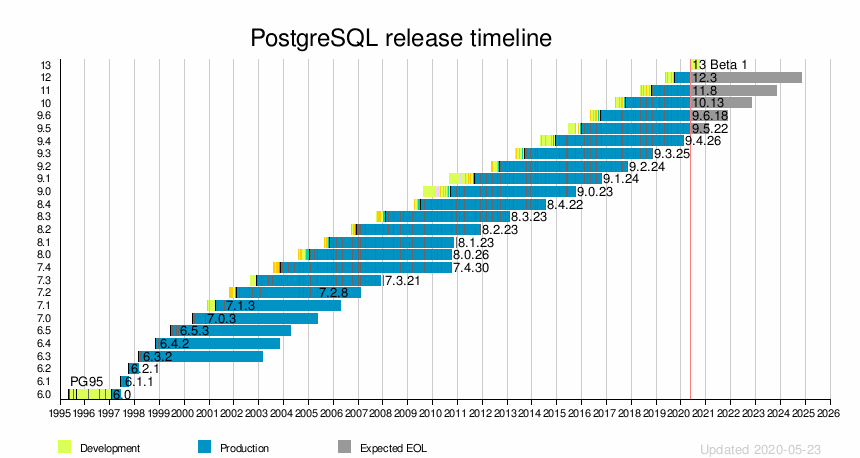On May 21, 2020, the PostgreSQL Global Development Group announced that the first beta release of PostgreSQL 13 was available for download. This release contains previews of all features that will be available in the final release of PostgreSQL 13, though some details of the release could change before then. Let's look at the new features and changes found in PostgreSQL 13.
In the community's published document, we can see that the new features of PostgreSQL 13 are divided into the following sections:
Other highlights:
In this blog, Zhuodao takes a look at all the new features and changes.
In this tutorial we have shown how to migrate from your relational PostgreSQL database to the ApsaraDB for Relational PostgreSQL database on the ApsaraDB for RDS Server.
Traditionally, databases have resided within instances of a database server such as SQL Server, MySQL, MongoDB and others.
Sometimes the database engine runs on the same server as the application whose data it stores. For example, a single Linux server might run Apache, PHP and MySQL.
As the application scales and more performance is required, moving the database to its own server is the obvious next step. Just set up a new Linux or Windows server, install the requisite database engine and migrate the data. Then it's just a case of changing some configuration files within the application code to point the application at the new database server.
As part of the world moved towards cloud computing infrastructure, new database server architecture arrived. Cloud providers such as Alibaba Cloud now offer database server instances as a service. No longer is there any need to run a dedicated Windows or Linux server purely to host a copy of MySQL or SQL Server. No longer do you need to patch your database server or manage its security.
Alibaba Cloud's database service is called ApsaraDB and it's currently available for SQL Server, MySQL, PostgreSQL, and Postgres Plus Advanced Server (PPAS), which is compatible with Oracle.
ApsaraDB instances are fast, cost-effective, easy to back up and very quick to scale when you need additional performance. They all run on SSD drives and you simply pay according to the amount of data you process. If you need more performance or storage, it can be arranged with just a few clicks on the management console. Pricing is based on a monthly subscription that starts from USD $29. Or if you prefer, a pay-as-you-go option starts from less than 3 cents ($0.29) per hour provided that your ApsaraDB instance is active (storage and Internet traffic are additional costs).
Just as with a cloud-based Linux or Windows server instance, ApsaraDB database instances include a comprehensive monitoring system that's built-in. You can keep a close eye on the performance of your hosted databases, in order to help you make decisions about whether additional resources might be required. You can set alarms and triggers so that you will automatically be notified if performance or disk space falls below specified thresholds.
With an ApsaraDB instance, there's no underlying operating system or virtual server for you to pay for, secure, patch or manage. You get to concentrate on managing just your database tables. Everything else is taken care of by Alibaba Cloud.
ApsaraDB includes security features such as real-time monitoring of network traffic, and automatic interception of SQL injection, brute force attacks and other types of database attacks. This is all built into each ApsaraDB instance and does not need to be configured or purchased separately, as would be the case if you hosted your databases on a conventional cloud server running Linux or Windows and a separate relational database management system (RDBMS).
This tutorial will show you how to migrate from a relational PostgreSQL to ApsaraDB for relational PostgreSQL Database.
Further information, as well as documentation about how to use other database technologies apart from PostgreSQL, can be found in the Database Services section of the Products menu on the Alibaba Cloud website.
ApsaraDB for PolarDB is a cloud-native relational database compatible with MySQL, PostgreSQL, and Oracle. ApsaraDB for PolarDB provides the performance and availability of traditional enterprise databases and the flexibility and cost-effectiveness of open-source databases.
ApsaraDB for PolarDB is designed for business-critical database applications that require fast performance, high concurrency, and automatic scaling. You can scale up to millions of queries per second and 100 TB per database cluster with 15 low latency read replicas. ApsaraDB for PolarDB is six times faster than standard MySQL databases, and delivers the security, reliability, and availability of traditional commercial databases at 1/10 the cost. ApsaraDB for PolarDB embodies the proven database technology and best practices honed over the last decade that supported hyper-scale events such as the Alibaba Double 11 Global Shopping Festival.
PolarDB is based on the cloud native architecture. PolarDB provides the benefits of commercial databases and open source cloud databases. Commercial databases offer the benefits of stability, reliability, high performance, and scalability. Open source cloud databases offer the benefits of simplicity, openness, and rapid iteration. This topic describes the architecture and features of PolarDB.
The Latest Features of DataWorks: How to Choose the Right Edition of DataWorks

2,598 posts | 769 followers
FollowAlibaba Clouder - February 11, 2020
ApsaraDB - January 22, 2021
digoal - August 20, 2021
ApsaraDB - September 23, 2021
digoal - September 6, 2019
digoal - September 12, 2019

2,598 posts | 769 followers
FollowMore Posts by Alibaba Clouder
Start building with 50+ products and up to 12 months usage for Elastic Compute Service
Get Started for Free Get Started for Free